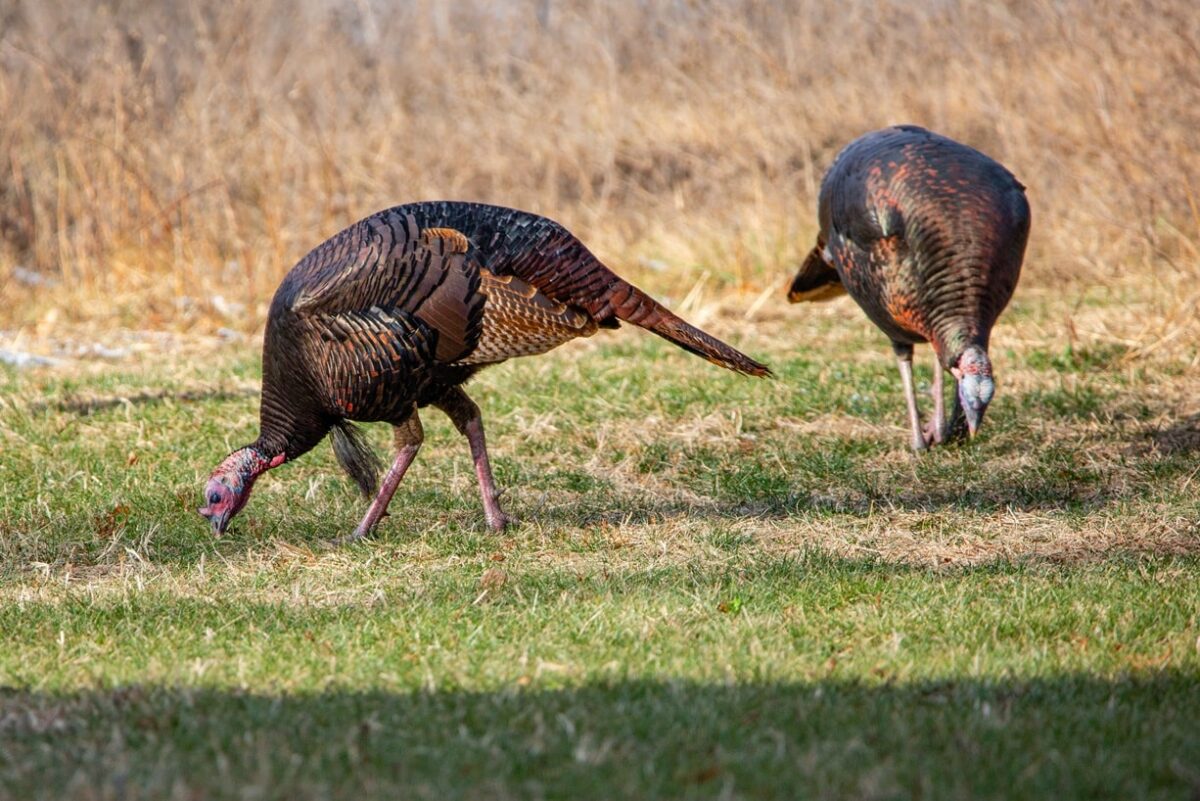Turkeys are large, ground-dwelling birds native to North America, living in forests and open grasslands. They are members of the Phasianidae family, which includes chickens, pheasants, and quail.
These birds have a distinctive appearance with a short tail and broad wings. They have a long, fleshy neck, a red wattle, and a fleshy protrusion called a snood. Turkeys typically have brown or black plumage, but there are also white and even blue varieties.
Turkeys are omnivores with a diet that includes grasses, seeds, fruits, nuts, insects, and small rodents. They are social animals, and during much of the year, females and males live in separate flocks of up to 30 birds until the breeding season, when they combine.
Table of Contents
What Do Wild Turkeys Eat?
Wild turkeys wander through forests, grasslands, pastures, and agricultural fields foraging for food. They spend their days walking on the ground and fly into low tree branches at night to roost, making it difficult for predators to prey on them.
Turkeys eat many foods, including grass, seeds, fruits, vegetables, insects, worms, grubs, and rodents. Farmers sometimes view them as pests because turkeys also eat corn, soybeans, and wheat, causing damage to farmers’ fields in the process.
Despite the real and perceived damage they inflict on agricultural fields, people can only legally hunt turkeys during their breeding season in the spring throughout most of the United States. Depending on the climate of each region, this season occurs in March, April, or May.

What Do Domestic Turkeys Eat?
People eat massive amounts of turkey worldwide. The United States is the largest turkey producer, with more than 5.5 billion pounds (2.5 billion kg) of turkey produced in 2021. They are also the largest turkey exporter, with 549 million pounds (249 million kg) exported in 2021.
Producing turkeys is a big business for small-scale and large corporate farms in the United States. Turkey is a staple food for hundreds of millions, especially in the United States, where an estimated 50 million turkeys are eaten on Thanksgiving alone.
Feeding domestic turkeys is a critical part of raising and producing them. Farmers, especially on large corporate farms, must balance the growth of turkeys with the cost of feeding them. The food turkeys eat makes up about two-thirds of the cost of raising the turkey.
As a result, farmers use specially formulated feeds containing corn and soybeans, which are relatively inexpensive ingredients and provide the best nutrition at the lowest cost. Over 4 to 5 months, one male turkey eats 2 to 3 times his final weight in commercial feed.
Domestic turkeys raised on small farms typically allow their birds to graze in pastures and pens, not cooped up in a building with thousands of other birds. These turkeys usually have a more natural diet than the corporate farm turkeys.
Turkeys that live in pastures or pens eat animal feeds containing corn, soybean, wheat, sorghum, and barley. However, these birds also forage for grass, insects, worms, seeds, fruits, vegetables, and rodents.
Regardless of whether turkeys are grown on corporate or small farms, farmers also typically supplement their birds’ diets by adding essential vitamins and minerals designed to maintain the health of their birds.
What Do Baby Turkeys Eat?
Wild baby turkeys, also called poults, are fed for a few days by their mother after hatching before learning to find their own food for themselves. These chicks stay with their mother and other mother/chick groups, forming large flocks throughout most of the first year.
The wild poults eat whatever they can find, including beetles, leafhoppers, crickets, soft grasses, and fruits. As they grow, their diet becomes more similar to that of the adults and reflects the diversity of the available food in their range.
Raising domestic poults can be challenging because farms typically experience around a 6% mortality rate for various reasons, including starvation and flipping. These reasons aren’t well understood, but ongoing research has attempted to decrease this mortality rate.
In addition, domestic poults typically have depleted protein after hatching. To battle the lack of protein, farmers feed them commercial feeds containing a high percentage of soybean and sufficient amino acids to encourage the rapid growth of the poults.
Many small farmers feed their poults a diet of starter feed, cracked corn, and freshwater to give them a good start and reduce the mortality rate their flock experiences. Domestic poults also get grubs, insects, and worms supplemented in their diet for a protein boost to encourage growth.
What Do Turkeys Eat in Winter?
Wild turkeys do not migrate south in winter and must eat whatever foods are available during this season. In the northern range of turkeys, low temperatures, bad weather, and heavy snowfall often reduce food availability during the winter.
The turkeys that live in more southerly climes, where food is available year-round, continue to enjoy a consistent diet of grasses, seeds, fruits, rodents, insects, and lizards. These turkeys do not have to worry about starving during the winter.
In the northern parts of their range, turkeys usually rely upon acorns, dead or dying herbaceous vegetation, seeds, insects, and waste grains from agricultural fields. These birds can lose weight and survive unless deep, powdery snow makes it hard for them to forage.
What Do Turkeys Eat in Spring?
As the winter recedes throughout the country, plants start growing, and new green plant life and insect life abound. As turkeys forage, a wider assortment of food comprises their diets during the spring, reflecting the increased availability of these foods.
Turkeys eat many insects during the spring, including crickets, grasshoppers, beetles, dragonflies, ants, and insect larvae. Additionally, they eat spiders, snails, slugs, ticks, centipedes, millipedes, and scorpions.
Once plants start regrowing in the spring, turkeys eat the tender shoots and greens of the new growth,fruits, vegetables, seeds, tubers, roots, bulbs, flowers, and leaves. The harsher the winter, the more bulbs, tubers, and plant roots the turkeys are willing to dig up.
